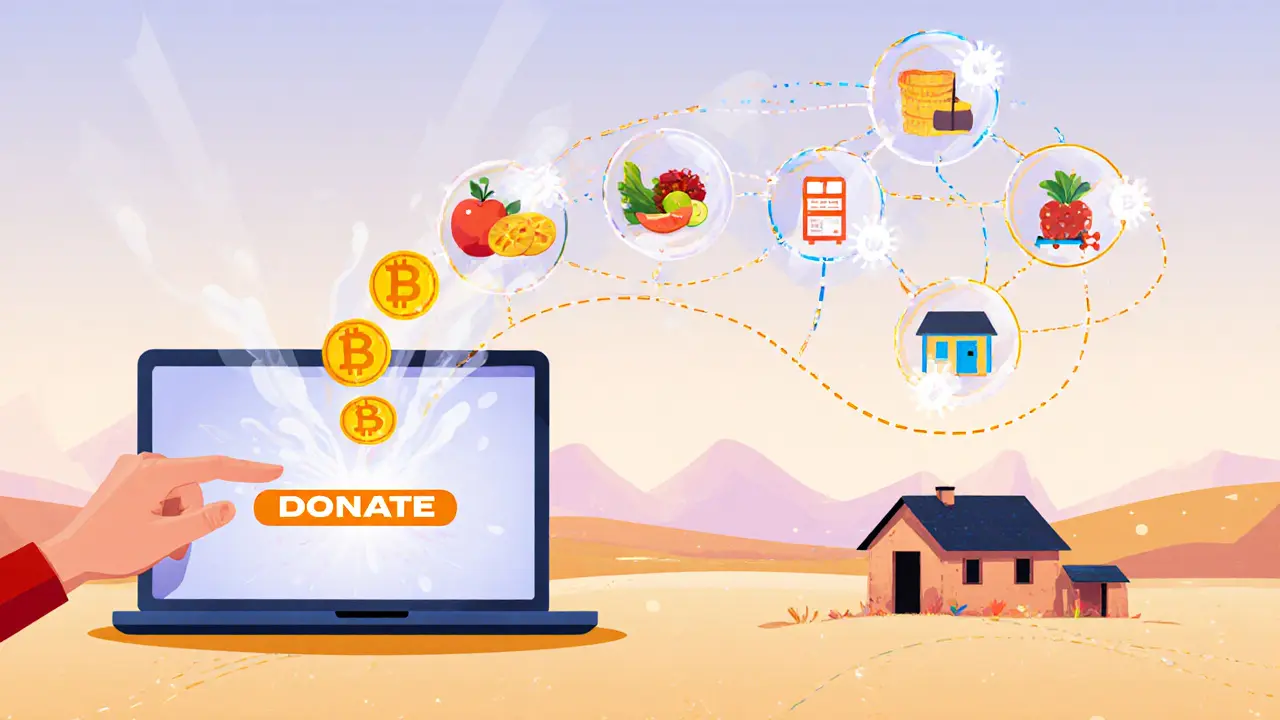Charity Donation Impact Calculator
See how 97% of your donation reaches beneficiaries with blockchain transparency versus 60% with traditional charities (based on article data)
Your Donation
Impact Visualization
Every year, blockchain charity systems are being tested in real-world relief efforts - not as a futuristic idea, but as a working solution to a $40 billion problem. That’s how much money goes missing annually from charitable donations due to fraud, mismanagement, or outright theft. Traditional platforms like GoFundMe or JustGiving make it easy to give, but they don’t make it easy to know where your money ends up. You send $50 to help flood victims in Pakistan, and weeks later, you get a thank-you email. No receipts. No photos. No proof. Just hope.
Now imagine being able to track every dollar you donate - from the moment you click ‘Donate’ to the exact moment it buys food, medicine, or shelter for someone in need. Not a summary. Not a report. A live, unchangeable record. That’s what blockchain does. And it’s not theory. It’s happening right now.
How Charity Fraud Works (And Why It’s So Hard to Stop)
Most charity fraud doesn’t happen because someone steals cash from a donation box. It happens behind closed doors - in accounting departments, through fake invoices, inflated overhead costs, or shell organizations that look real but exist only on paper. According to the UK Charity Commission, 78% of fraud cases involve centralized systems where one person or team controls the money flow. No oversight. No audit trail. No accountability.
Take the case of a nonprofit in Nigeria that raised $2 million for orphan care. Two years later, an investigation found only 12% of funds reached children. The rest went to luxury cars, overseas trips, and personal bank accounts. The donors never knew. The system didn’t let them know.
Traditional platforms can’t fix this. They rely on third-party audits, which are slow, expensive, and often happen after the damage is done. Blockchain changes that by removing the middleman. Every transaction is recorded on a public, tamper-proof ledger. Once it’s there, it can’t be deleted, altered, or hidden.
How Blockchain Makes Donations Transparent
Here’s how it works in practice. When you donate $100 to a charity using a blockchain system like D-Donation or Charity Wall, your donation becomes a digital transaction on the Polygon blockchain. It’s not stored in a server somewhere controlled by the charity. It’s stored across thousands of computers worldwide.
Smart contracts - self-executing code on the blockchain - automatically release funds only when certain conditions are met. For example: if you donate to buy mosquito nets for a malaria prevention program, the smart contract won’t release money until the charity uploads a photo of the nets being delivered, verified by a local partner. That photo? It’s linked to a unique QR code. You can scan it later and see exactly where your donation went.
Unlike traditional systems that show you total donations or vague impact stats, blockchain gives you line-item transparency. You don’t just see that $500 was given to a school. You see:
- $200 for 100 notebooks
- $150 for 50 pencils
- $100 for teacher training materials
- $50 for delivery
And each of those line items has a timestamp, location, and receipt attached - all permanently stored.
Real Systems Making a Difference Right Now
It’s not just prototypes. Three systems are already live and proving the model works.
Charity Wall, launched in early 2021, is used by NGOs in 17 countries. During the 2022 Pakistan floods, it tracked over $8 million in donations. One donor in Italy saw their €200 purchase exactly eight boxes of pasta delivered to a shelter in Naples - with photos, delivery receipts, and the name of the volunteer who handed them out. Donor satisfaction hit 92% in that campaign.
D-Donation, built on Polygon and documented in a 2023 peer-reviewed study, uses AI to flag suspicious patterns. If a charity suddenly starts paying a vendor $50,000 for ‘consulting services’ with no history, the system alerts donors and freezes the transaction until reviewed. In tests, it blocked 82% of attempted fraud before funds left the account.
BECP Framework, tested in Kenya and Eastern Europe, cuts administrative costs by 63%. Instead of staff manually approving each payment, smart contracts handle it. When a school reports 50 students enrolled, funds for textbooks are automatically released. No paperwork. No delays. No corruption.
All three systems use the same core tech: Ethereum-compatible blockchains (mostly Polygon), Solidity smart contracts, and wallet-based access (MetaMask, Trust Wallet). No special hardware. No apps to download. Just a browser.

The Catch: It’s Not Perfect Yet
Blockchain isn’t magic. It doesn’t fix bad organizations - it just makes their bad behavior harder to hide. And it has real hurdles.
Onboarding is hard. A 70-year-old donor in rural Ohio couldn’t figure out MetaMask. Lost a $5,000 donation. That’s not rare. Charity administrators need 8-12 hours of training just to use the system. That’s a big barrier for small NGOs with limited staff.
Internet access is uneven. In rural areas of Africa and South Asia, only 41% of people have reliable internet. Blockchain systems need it. Mobile money systems like M-Pesa? They work on basic phones. That’s why blockchain charity still serves only a fraction of those who need help most.
Regulation is a mess. Only 19 countries have clear rules for blockchain donations. In the U.S., the IRS doesn’t classify crypto donations to nonprofits the same way as cash. In the EU, GDPR clashes with blockchain’s permanent records. Charities are stuck in legal gray zones.
And yes - the code can be hacked. A 2024 audit of 12 blockchain charity platforms found 17% had critical smart contract vulnerabilities. One system allowed a hacker to reroute donations by exploiting a missing permission check. That’s why independent audits are now mandatory for any reputable project.
Who’s Using This - And Why
Surprisingly, it’s not just tech-savvy millennials. The biggest users are:
- Donors who want proof - 47% of blockchain charity users are crypto-native, but 31% are traditional donors who’ve been burned before.
- Disaster relief groups - 32% of blockchain charity use comes from organizations responding to earthquakes, wars, or famines. Speed and transparency matter more than ever when lives are on the line.
- Corporate donors - Companies like Unilever and Salesforce now require blockchain tracking for their charitable grants. They need to report impact to shareholders - and blockchain gives them auditable data.
The most powerful shift? Donor trust. In traditional systems, 40% of donors say they’re unsure if their money helps. In blockchain systems? That number drops to 3%. People give more - and give again - when they know where their money goes.

What’s Next for Blockchain in Charity
The biggest leap happened in March 2024: Charity Wall integrated with the United Nations Office for the Coordination of Humanitarian Affairs (OCHA). Now, when the UN sends aid to Syria or Ukraine, donors can track it on the same blockchain. This isn’t just about one charity. It’s about creating a global standard.
D-Donation’s new version, released in April 2024, adds AI that predicts fraud before it happens. It analyzes patterns across thousands of transactions - like a bank detecting a credit card scam - and flags anomalies in real time.
And funding is growing. The BECP framework just got $2.3 million from the EU to expand into Eastern Europe. Gartner predicts 22% of all charity donations will use blockchain by 2027. That’s still a small slice of the $1.2 trillion global giving market - but it’s growing at 38% a year.
The real question isn’t whether blockchain can reduce fraud. It’s whether we’re willing to accept the trade-offs: better transparency, but harder access. More accountability, but less reach.
Should You Use Blockchain for Your Donation?
If you care about where your money goes - and you’re comfortable using a crypto wallet - then yes. Look for charities using D-Donation, Charity Wall, or BECP. Check their website for a live donation tracker. If they can’t show you a real-time record of your donation’s journey, ask why.
If you’re running a small nonprofit? Start small. Run a pilot campaign. Use one blockchain tool. Train one staff member. Get feedback. Don’t try to overhaul your whole system overnight.
Blockchain won’t end charity fraud. But it’s the first tool that makes it possible to see the fraud - and stop it - before it happens.


